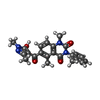+ Open data
Open data
- Basic information
Basic information
| Entry | Database: PDB / ID: 7ezq | ||||||
|---|---|---|---|---|---|---|---|
| Title | Complex structure of AtHPPD with inhibitor Y15832 | ||||||
 Components Components | 4-hydroxyphenylpyruvate dioxygenase | ||||||
 Keywords Keywords | HYDROLASE / Complex / inhibitor | ||||||
| Function / homology |  Function and homology information Function and homology information4-hydroxyphenylpyruvate dioxygenase / 4-hydroxyphenylpyruvate dioxygenase activity / L-tyrosine catabolic process / L-phenylalanine catabolic process / iron ion binding / identical protein binding / cytoplasm Similarity search - Function | ||||||
| Biological species |  | ||||||
| Method |  X-RAY DIFFRACTION / X-RAY DIFFRACTION /  SYNCHROTRON / SYNCHROTRON /  MOLECULAR REPLACEMENT / Resolution: 1.886 Å MOLECULAR REPLACEMENT / Resolution: 1.886 Å | ||||||
 Authors Authors | Lin, H.Y. / Yang, G.F. | ||||||
| Funding support |  China, 1items China, 1items
| ||||||
 Citation Citation |  Journal: To Be Published Journal: To Be PublishedTitle: Complex structure of AtHPPD with inhibitor Y18093 Authors: Lin, H.Y. / Yang, G.F. | ||||||
| History |
|
- Structure visualization
Structure visualization
| Structure viewer | Molecule:  Molmil Molmil Jmol/JSmol Jmol/JSmol |
|---|
- Downloads & links
Downloads & links
- Download
Download
| PDBx/mmCIF format |  7ezq.cif.gz 7ezq.cif.gz | 96.4 KB | Display |  PDBx/mmCIF format PDBx/mmCIF format |
|---|---|---|---|---|
| PDB format |  pdb7ezq.ent.gz pdb7ezq.ent.gz | 69.1 KB | Display |  PDB format PDB format |
| PDBx/mmJSON format |  7ezq.json.gz 7ezq.json.gz | Tree view |  PDBx/mmJSON format PDBx/mmJSON format | |
| Others |  Other downloads Other downloads |
-Validation report
| Summary document |  7ezq_validation.pdf.gz 7ezq_validation.pdf.gz | 1.1 MB | Display |  wwPDB validaton report wwPDB validaton report |
|---|---|---|---|---|
| Full document |  7ezq_full_validation.pdf.gz 7ezq_full_validation.pdf.gz | 1.1 MB | Display | |
| Data in XML |  7ezq_validation.xml.gz 7ezq_validation.xml.gz | 18.3 KB | Display | |
| Data in CIF |  7ezq_validation.cif.gz 7ezq_validation.cif.gz | 26.6 KB | Display | |
| Arichive directory |  https://data.pdbj.org/pub/pdb/validation_reports/ez/7ezq https://data.pdbj.org/pub/pdb/validation_reports/ez/7ezq ftp://data.pdbj.org/pub/pdb/validation_reports/ez/7ezq ftp://data.pdbj.org/pub/pdb/validation_reports/ez/7ezq | HTTPS FTP |
-Related structure data
| Related structure data |  7cjkC  6m6dS S: Starting model for refinement C: citing same article ( |
|---|---|
| Similar structure data | Similarity search - Function & homology  F&H Search F&H Search |
- Links
Links
- Assembly
Assembly
| Deposited unit | 
| ||||||||
|---|---|---|---|---|---|---|---|---|---|
| 1 | 
| ||||||||
| Unit cell |
| ||||||||
| Components on special symmetry positions |
|
- Components
Components
| #1: Protein | Mass: 45225.891 Da / Num. of mol.: 1 Source method: isolated from a genetically manipulated source Source: (gene. exp.)   References: UniProt: P93836, 4-hydroxyphenylpyruvate dioxygenase |
|---|---|
| #2: Chemical | ChemComp-0O0 / |
| #3: Chemical | ChemComp-CO / |
| #4: Water | ChemComp-HOH / |
| Has ligand of interest | Y |
| Has protein modification | Y |
-Experimental details
-Experiment
| Experiment | Method:  X-RAY DIFFRACTION / Number of used crystals: 1 X-RAY DIFFRACTION / Number of used crystals: 1 |
|---|
- Sample preparation
Sample preparation
| Crystal | Density Matthews: 2.29 Å3/Da / Density % sol: 46.28 % |
|---|---|
| Crystal grow | Temperature: 293 K / Method: vapor diffusion, hanging drop Details: 0.1M Tris/Bicine pH 8.5, 15% (v/v) MPD, 15% (w/v) PEG 1000, 15% (w/v) PEG 3350, 0.03M NaBr, 0.03M NaF, 0.03M NaI |
-Data collection
| Diffraction | Mean temperature: 100 K / Serial crystal experiment: N |
|---|---|
| Diffraction source | Source:  SYNCHROTRON / Site: SYNCHROTRON / Site:  SSRF SSRF  / Beamline: BL17U1 / Wavelength: 1 Å / Beamline: BL17U1 / Wavelength: 1 Å |
| Detector | Type: ADSC QUANTUM 315r / Detector: CCD / Date: May 8, 2020 |
| Radiation | Protocol: SINGLE WAVELENGTH / Monochromatic (M) / Laue (L): M / Scattering type: x-ray |
| Radiation wavelength | Wavelength: 1 Å / Relative weight: 1 |
| Reflection | Resolution: 1.886→50 Å / Num. obs: 28620 / % possible obs: 94.5 % / Redundancy: 3.4 % / CC1/2: 0.984 / Rmerge(I) obs: 0.068 / Net I/σ(I): 14.91 |
| Reflection shell | Resolution: 1.9→1.93 Å / Num. unique obs: 1404 / CC1/2: 0.722 / % possible all: 94.7 |
- Processing
Processing
| Software |
| |||||||||||||||||||||||||||||||||||||||||||||||||||||||||||||||||||||||||||||
|---|---|---|---|---|---|---|---|---|---|---|---|---|---|---|---|---|---|---|---|---|---|---|---|---|---|---|---|---|---|---|---|---|---|---|---|---|---|---|---|---|---|---|---|---|---|---|---|---|---|---|---|---|---|---|---|---|---|---|---|---|---|---|---|---|---|---|---|---|---|---|---|---|---|---|---|---|---|---|
| Refinement | Method to determine structure:  MOLECULAR REPLACEMENT MOLECULAR REPLACEMENTStarting model: 6M6D Resolution: 1.886→41.873 Å / SU ML: 0.2 / Cross valid method: FREE R-VALUE / σ(F): 1.37 / Phase error: 23.69 / Stereochemistry target values: ML
| |||||||||||||||||||||||||||||||||||||||||||||||||||||||||||||||||||||||||||||
| Solvent computation | Shrinkage radii: 0.9 Å / VDW probe radii: 1.11 Å / Solvent model: FLAT BULK SOLVENT MODEL | |||||||||||||||||||||||||||||||||||||||||||||||||||||||||||||||||||||||||||||
| Refinement step | Cycle: LAST / Resolution: 1.886→41.873 Å
| |||||||||||||||||||||||||||||||||||||||||||||||||||||||||||||||||||||||||||||
| Refine LS restraints |
| |||||||||||||||||||||||||||||||||||||||||||||||||||||||||||||||||||||||||||||
| LS refinement shell |
|
 Movie
Movie Controller
Controller



 PDBj
PDBj





